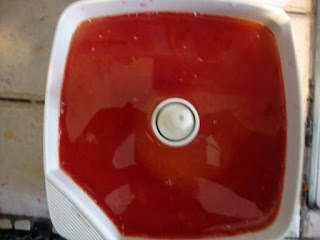After Christmas, the school began a cycle of three excursions into Rome. This allows the opportunity to break the school into three manageably sized groups rather than trying to get all of the students simultaneously into some of the major sites. All students do the Vatican Museum and the Forum/Colosseum/Palatine Hill. Then they chose from among three, one-time offers. In January, Amy took a group to Ostia Antica. For the second trip, last Friday, neither of us was responsible for a group so we decided to break away and do something completely different with our friends the H-Ps. When Amy and I were here in 1996, we took a tour of some of the Christian catacombs along the Appian Way. I suggested that we explore the actual road this time.
We arrived at Ostiense, the terminus of the Viterbo-Rome line, and decided to walk rather than catch a bus. It was another gorgeous day, blue skies, temps near 70 and nearly no wind. Unfortunately, the walk was mostly along very heavily traveled streets and was rather unpleasant. We did manage to catch a very nice view of the city walls.
At Porta San Sebastiano we turned right and headed into the Parco Regionale dell’Appia Antica. The first kilometer or more was a really narrow, heavily traveled road with not much of a sidewalk to speak of. Along the way we passed a reproduction of the 1 mile column set into the stone wall beside the road. That is right, the entrance to this park is little more than 2 km from the Forum, provided you know which direction to walk in.
We had been told that the best way to see the park was to rent a bicycle, so we found our way to the park information center and discovered that “renting” from that particular location was actually free and that we could make a donation when we returned the bikes. So, fortified with maps, water, helmets and bikes we set out for a ride into antiquity.
The Via Appia is named after Appius Claudius Caecus who completed the first section in 312 BC. It was originally a military road intended to resupply troops stationed to the south of the city. It runs straight as an arrow with no regard to the surrounding terrain. The road was constructed in what became the traditional Roman road configuration. They dug down into the ground to build a base of rocks, mortar and stones to provide a stable foundation and drainage and then laid huge basalt blocks over the top. These blocks are roughly 1x1x2 feet and weigh hundreds of pounds. Some sections of the original road still exist. You get a sense of the road in the picture below, looking back along the road toward Rome from the intersection with Via Tor Carbone.
Along the sides of the road were majestic villas and fields. The edge of the road was lined with tombs and other funerary monuments. The relative importance of the tombs can be ascertained by their proximity to the walls and by their size. Close and/or big = important. We began by traveling past the catacombs, but did not stop. Once we hit the main road, there was a short stretch with heavy traffic and then we were on the limited access portion of the road. One of the first noticeable monuments you encounter is the Tomb of Caecilia Metella. While it probably had a mounded roof originally, it is now topped by a crenellated crown.
Not far from the Tomb of Cecilia Metella we stopped for coffee at a bar and then bought sandwiches at a small shop. We picnicked near a temple shaped ruin, shown below.
Below is a randomly encountered octagonal tomb structure. I don't know who it was for. There are dozens of these types of things both very near the road and a few meters off the beaten path. They are not all identified in the literature I have.
We turned around at the Villa dei Quintili and headed back after a 5 mile ride. The villa must have been magnificent in its time. It was constructed by wealthy brothers who were then killed and the property seized by Emperor Commodus (depicted in the movie Gladiator), a brutal nutcase who really didn't enjoy it when somebody had nicer toys than he did.
Over time some of the road has shifted path so that there is now a completely separate Via Appia Nuova. The park itself is relatively new. The shape of the park took form in 1988-98 and in 2002 a plan was created for managing the park. This includes limiting access to the main road to only pedestrians and bicycles except for local traffic from businesses and people who live along the way. That's right, you can still live on the Appian Way. The entire section of road contained within the park is some 22 km long, enough for a very long but beautiful one-day ride. It was a marvelous day all around and we returned our bicycles leaving a 20 euro donation and did the sensible thing, catching the 118 bus back into the city. It takes you right to the Ostiense Train Station - if only we had realized how easy it was we could have taken the bus on the way there also. This has to be one of the most evocative journeys you can make and we recommend it highly.


















































